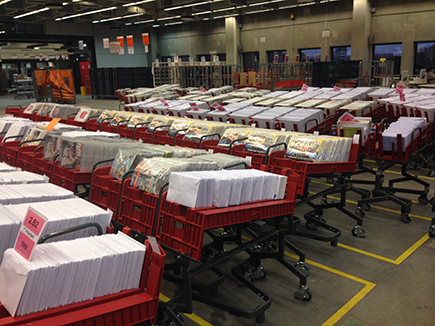PostNL is extremely pleased with the upgrades it has rolled out to six of its sorting centers in the Netherlands, but could not have succeeded without help from Prime Vision and Solystic. René Boot, information and computing director, PostNL, explains the changes: “We have improved the sorting capability of our centers and reduced the numbers of rejected items,” he says. “With help from Prime Vision and Solystic, PostNL now has a smart, efficient sorting system that provides a wealth of data. We can share information between passes and sorting centers like never before, reducing the amount of coding required for flats. This is something we are looking forward to expanding upon in the near future.”
In 2013 PostNL decided to make improvements to its sorting centers. The project involved the roll-out of 11 mixed sorting machines (SMX) to the six sites and also new MMS (Mail Match System) control software. While Solystic provided the sorting machines, Prime Vision handled the MMS applications.

The three companies worked closely together to achieve the right results. “Solystic was involved in the interface development with Prime Vision,” says Maurizio Puppo, director of marketing and communication at Solystic. “It shows how well we work with IT providers, and the benefit for PostNL is that it can now process all previously non-conveyable items, with mail pieces tagged with a printed sorting information label. ” PostNL plans to increase the use of the MMS software throughout its operations.
“Before MMS, PostNL was running on a number of different systems and data between various applications that could not be shared,” explains Hans Kamperman, operations director at Prime Vision. “Now, with the software in place in 11 systems and another 69 planned, one holistic view has been established, and operational decision making can be taken instantly, based on the information received from the various processes. The system also gives full data about the machine and its operations, which means predictive maintenance, better planning and forecasting.”
René Boot describes the expansion plans in more detail: “Five additional SMXs will be installed across the network, as well as a variety of other machines,” he says. “It will create a network of shared information.” Having one type of software overseeing the processes will make future upgrades and improvements easier to implement. “This type of system is a first for the postal market,” adds Kamperman. “We created this to be a flexible, modular solution, and it can grow and change as required.”
Sorting Center Innovation of the Year shortlist:
- Bell and Howell’s Data Protection Recovery service
- Siemens’ Intelligent Data Entry Workplace (IDEW)
- Intralox’s automatic culling system for flats
- Beumer Group’s Rota-Sorter
- Denipro’s Denisort
- PostNL, Prime Vision and Solystic’s SMX-MMS Dynamic Mail Processing solution
- Soly by Solystic


